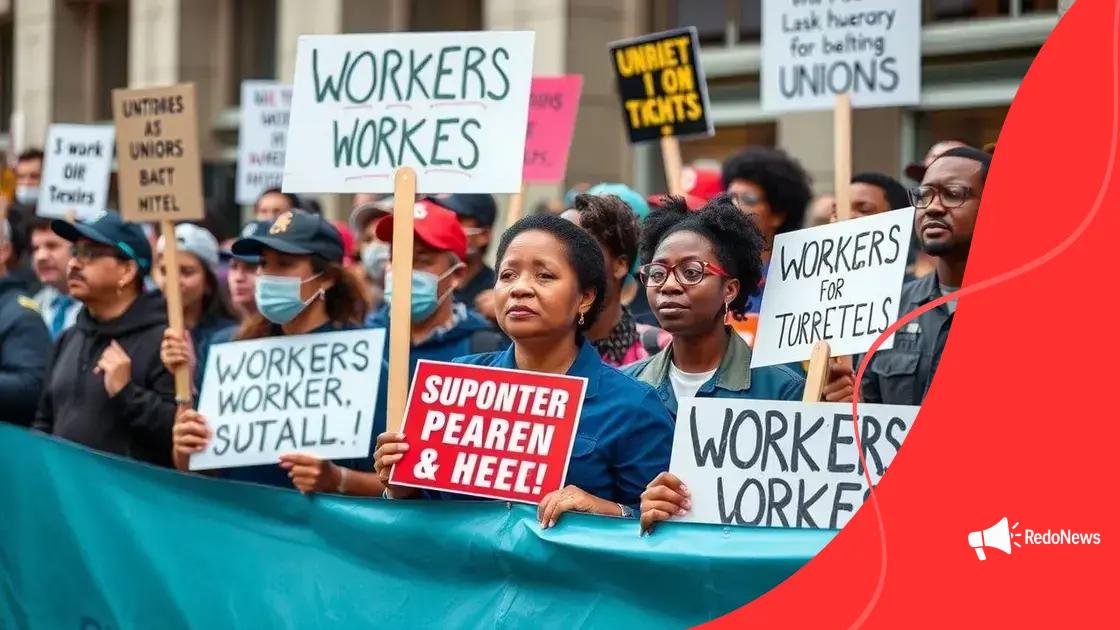Labor union activity increases: what it means for workers

Labor union activity increases as workers seek better wages, benefits, and job security, pushing unions to adapt to new work environments and advocate effectively for diverse member needs.
Labor union activity increases across industries, impacting workers’ rights and workplace dynamics. Have you noticed changes in your own workplace? Let’s explore what this trend means for you.
Understanding labor union activity
Understanding labor union activity is essential for recognizing its impact on workers’ rights and workplace environments. As more employees join unions, the collective voice can bring significant changes.
What Are Labor Unions?
Labor unions are organizations that represent the collective interests of workers. They act as a bridge between employees and employers, advocating for better wages, benefits, and working conditions. This representation can empower workers to have a say in important decisions affecting their jobs.
Key Roles of Labor Unions
Unions play several critical roles:
- Collective Bargaining: Unions negotiate contracts for wages and benefits.
- Employee Representation: They represent members in disputes with management.
- Advocacy: Unions advocate for labor-friendly policies at local and national levels.
Moreover, unions can promote safety standards and improve workplace conditions. When workers join forces, they create a powerful voice that can demand changes that individual workers might not be able to achieve alone. Collaboration within unions helps to foster solidarity among employees.
Additionally, understanding union membership trends can reveal much about the workplace climate. Over recent years, there has been an increase in worker activism and interest in unionization across various sectors, including technology and service industries. This shift reflects a broader desire for more equitable treatment and respect in the workplace.
The Benefits of Union Activity
There are numerous advantages to increased labor union activity. For instance:
- Higher Wages: Union workers usually earn more than their non-union counterparts.
- Better Benefits: Unions often secure better health and retirement benefits for their members.
- Job Security: Workers may enjoy enhanced job protection through union agreements.
As labor union activity increases, employees can experience not just better wages but also a more secure and dignified working environment. It’s an evolving landscape that merits attention and understanding.
Benefits of increased union participation
The benefits of increased union participation are wide-ranging and impactful. As more workers join together, they create a stronger voice for advocacy, leading to positive changes in the workplace.
Improved Wages
One significant advantage is the potential for improved wages. Union members often earn higher salaries compared to non-union workers. This increase can mean a better quality of life for union members and their families.
Enhanced Benefits
Unions also secure better benefits for their members. These benefits can include:
- Health Insurance: Comprehensive health plans that cover a wider array of medical services.
- Retirement Plans: More robust retirement options that ensure financial security in later years.
- Paid Leave: Access to paid sick leave and parental leave, supporting work-life balance.
When unions negotiate collective bargaining agreements, they focus on providing better working conditions, which can lead to a healthier and happier workforce. Enhanced benefits encourage more employees to join, forming a cycle of growth and improvement.
The increased participation in unions can also lead to greater job security. With a united front, workers can negotiate terms that protect their positions and stabilize their employment status. Feeling secure at work contributes to overall morale and productivity.
Stronger Workplace Protections
Another important benefit is the stronger workplace protections that unions provide.
- Safety Standards: Unions advocate for safer working conditions and equipment.
- Fair Treatment: They ensure that all employees are treated equally, reducing discrimination and unfair practices.
- Support in Conflicts: Unions offer representation in disputes, giving workers a fair chance in conflicts with management.
The increase in union participation ultimately fosters a sense of community among workers. This shared experience and solidarity among employees make workplaces more comfortable and cooperative environments. Additionally, as unions grow, they can influence labor policies on a larger scale, benefiting not just their members but the workforce at large.
Current trends in labor union growth

Current trends in labor union growth show a significant shift in how workers view unionization. More employees are recognizing the benefits of collective action and are becoming more active in joining unions.
Increased Interest Among Young Workers
One notable trend is the growing interest among younger workers. Many millennials and Gen Z employees are seeking better working conditions and benefits. As a result, they are often more open to joining unions. This generation values community and collaboration, which unions provide.
Industries Seeing Growth
Unions are expanding in various industries, including:
- Technology: Workers in tech companies are organizing for better work-life balance and fair pay.
- Healthcare: Employees are advocating for adequate staffing and better patient care conditions.
- Service Industry: Service workers are pushing for higher wages and improved working conditions.
This growth across different sectors indicates a widespread acknowledgment of the importance of union representation.
Moreover, as labor union participation grows, so does the support from the community. Events such as rallies and strikes often attract attention, leading to increased public awareness about workers’ rights and issues. Social media plays a vital role in spreading information and mobilizing support for union initiatives. Through platforms like Twitter and Instagram, workers share their stories and organize collective actions, uniting their voices.
Legislative Changes
Another factor influencing union growth is legislative changes. Policies that promote workers’ rights and make it easier to join unions are emerging in various states. Some regions are adopting laws that strengthen labor protections, making union membership more appealing. As a result, workers feel empowered to organize and advocate for their rights.
The COVID-19 pandemic has also accelerated the conversation around labor issues. Many workers have experienced burnout and inadequate support during this time, driving them to seek better representation through unions. This trend shows a profound shift in worker expectations and a demand for more equitable treatment.
In essence, the landscape of labor unions is evolving. Increased visibility, legislative support, and a young, active workforce are paving the way for a renaissance in union participation. These developments may lead to a more robust movement focused on advocating for fair labor practices and enhancing the quality of life for workers across the nation.
Challenges faced by labor unions today
Challenges faced by labor unions today are significant and multifaceted. As unions strive to represent workers, they must navigate a changing economic and political landscape.
Declining Membership
One major challenge is the decline in union membership. Many workers are unaware of the benefits that unions offer. This lack of knowledge can result in lower participation rates, hindering unions’ ability to effectively advocate for workers’ rights. Some employees may also fear job loss if they join a union, which can further decrease interest in membership.
Legislative Obstacles
Unions also face numerous legislative obstacles that can limit their influence. These include:
- Right-to-Work Laws: These laws can weaken unions by allowing workers to benefit from collective bargaining without paying dues.
- Anti-Union Sentiment: Some political leaders actively oppose unionization efforts, making it harder for unions to organize.
- Legal Restrictions: New regulations can impose restrictions on union activities, making organizing more challenging.
These obstacles can create an environment where unions struggle to gain traction, limiting their ability to protect workers effectively.
In addition, employers are increasingly adopting aggressive anti-union tactics. Some may employ consultants to discourage unionization, using misinformation to instill fear among workers. This situation makes it critical for unions to develop effective communication strategies that inform and engage potential members about the benefits of unionizing.
Economic Pressures
The economic landscape presents another challenge. As industries evolve and the gig economy grows, unions have to find ways to reach and support workers in non-traditional roles. Many gig workers lack the protections that traditional employees enjoy, making it difficult for unions to advocate for them.
Moreover, economic downturns can lead to job losses and increased competition. In such environments, workers may feel less secure, thus delaying their willingness to join or support unions. Addressing these economic pressures is essential for unions to thrive.
Overall, despite the challenges faced by labor unions today, they remain vital for advocating workers’ rights and improving working conditions. Finding innovative strategies to engage workers and overcome legislative and economic barriers will be crucial for their ongoing success.
Future outlook for labor unions
The future outlook for labor unions presents both challenges and opportunities as the workforce evolves. Understanding these dynamics can help predict how unions will shape the labor market in the coming years.
Adapting to New Work Environments
One key area for unions is adapting to the rise of remote and gig work. As more professionals work outside traditional offices, unions need to find ways to represent these workers effectively. This shift requires innovative strategies to engage workers who may not have a fixed workplace or may work on flexible contracts.
Increasing Advocacy and Engagement
In response to growing demands for workers’ rights, unions may increase their advocacy efforts. They can focus on:
- Legislative Change: Pushing for laws that support fair wages and benefits for all workers.
- Community Building: Creating networks that connect union members, even in diverse industries.
- Training Programs: Offering resources that help workers build skills for the future job market.
These initiatives can help unions remain relevant and demonstrate their value to both workers and employers.
Embracing Technology
Technology will play an essential role in shaping the future of labor unions. Unions can leverage tools like social media and apps to reach younger workers effectively. Sharing success stories and providing updates on union activities can foster a sense of community and encourage participation.
Moreover, unions could utilize data analytics to identify worker needs better and tailor their services accordingly. By understanding trends and preferences, unions can create targeted programs that resonate with their members.
The Importance of Solidarity
As labor union membership trends continue to change, fostering solidarity among workers will remain crucial. This solidarity can drive collective action, leading to positive changes in the workplace. Workers have shown a recent surge in interest in union organizing, and maintaining this momentum will be vital for the future.
Additionally, the ongoing conversation about employee rights in various industries highlights an urgent need for strong unions. As this dialogue continues, unions can position themselves as essential advocates in promoting fairness and justice in the workplace. By doing so, they can ensure their continued relevance and impact.
In summary, the future of labor unions hinges on their ability to adapt to changing times and worker needs. As we’ve seen, unions are navigating challenges like declining membership, legislative hurdles, and the rise of gig work. However, there are also exciting opportunities ahead. By leveraging technology, advocating for workers’ rights, and fostering solidarity, unions can position themselves as crucial advocates for all workers. As the landscape continues to evolve, the resilience and creativity of labor unions will play a key role in shaping a fair and just workplace for everyone.
FAQ – Frequently Asked Questions about Labor Unions
What challenges do labor unions face today?
Labor unions face challenges such as declining membership, legislative hurdles, and adapting to gig work, which require innovative strategies to overcome.
How can unions increase their membership?
Unions can increase membership by raising awareness about their benefits, advocating for workers’ rights, and using technology to engage younger workers.
What role does technology play in the future of labor unions?
Technology can help unions communicate better with members, organize activities, and use data to understand workers’ needs more effectively.
Why is solidarity important for labor unions?
Solidarity is crucial as it strengthens the collective voice of workers, enhances support for union initiatives, and encourages greater participation.
